What Is the Blue Circl3 on a Fire Hydrant
Fire hydrants are painted different colors to win the trifecta of maintenance, safety, and precise communication
Fire hydrants are reservoirs for life-saving water. Many people are unaware, however, that the paint color and select markings on a specific hydrant convey key information to aid in firefighting and safety. How much water will be available, and how quickly? Is the hydrant water potable? Are there precautions when opening and closing the hydrant? Will there be enough water pressure? Fire hydrant colors and markings can answer all of these questions.
Fire hydrant colors are actually less descriptive of the hydrant than they are revealing of the machinations humming below ground: the pipe, the main, and the flow. The hydrant is the tip of the iceberg, signifying through its color what lies beneath the surface in terms of functionality. In this article, we put some meaning behind fire hydrant colors.
If you are looking for fire hydrant caps, Storz fire hydrant caps, Storz adapters for hydrants, or pitot gauges used to test GPM, QRFS has them.

The standardization of fire hydrant colors
Knowledge of hydrant colors communicates key information that allows snap decision-making before hooking up a fire hose, but this highly codified color system is not uniform across the United States.
The National Fire Protection Association (NFPA) has defined hydrant color coding, yet many jurisdictions have also developed specific color-code charts and rules of their own. At the same time, the Occupational Safety and Health Administration (OSHA) and the American Water Works Association suggest additional national color water safety recommendations.
NFPA 291 : Recommended Practice for Fire Flow Testing and Marking of Hydrants covers labeling and hydrant colors, but this document can ultimately act only as a guideline rather than a definitive handbook of all hydrant color meanings.
The result of NFPA 291, other guidelines, and local jurisdictional choices and laws is an imperfect system that requires specific training on hydrant color coding for every fire district. It is possible to make some generalizations about color, however, because NFPA's recommendations are commonly used.
This article covers NFPA, OSHA, and American Water Works guidelines, while offering illustrative examples of how local practices in color-coding may change the meaning of each color. But before getting into which hydrant color indicates what, let's outline how fire hydrants work and how they contribute to fire safety.
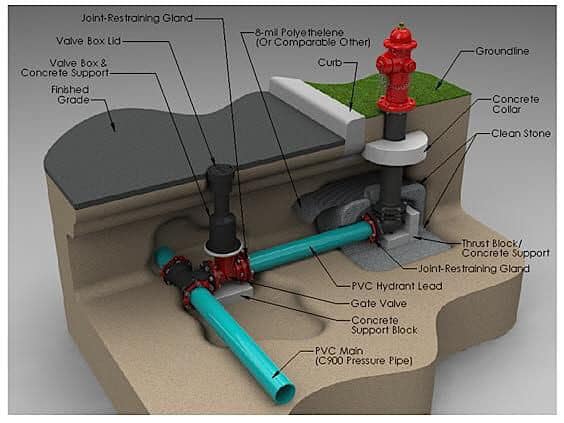
The anatomy of a fire hydrant
A fire hydrant is an aboveground pipe fitting designed to allow a quick access port for fire hoses, which can then be attached to the fire truck to divide the water stream into several more streams (via additional fire hoses). Multiple fire hoses are key to fighting large fires successfully.
Fire hydrants are deceptively simple in design but, for optimal use, they require a reliable water source and regular maintenance. From the time hydrants first appeared on city corners in urban American settings in 1801, these mainstays of firefighting haven't changed their basic stripes: they remain pipe fittings with a nut or bolt to release water, and connection points for fire hose hookup. A significant innovation, however, is increasingly common Storz hookups that enable a quicker, more reliable connection than threaded connections.
The majority of hydrants tap into potable or drinking water supplies, although some draw from ponds, lakes and other non-potable sources. Regardless of color or location, all hydrants are placed directly above a riser, or vertical channel, that reaches down a few feet into a larger horizontal pipe (whether a feeder or distributor) that eventually connects to the water main.
The hydrant itself doesn't include a mechanical device to alter water pressure: it acts only as an accessible valve that is either in "on" or "off" mode and channels a larger water supply. For a simple but succinct explanation of hydrant mechanics, this video explains how they operate:
Dry and wet barrel fire hydrants
Fire hydrants are built in two basic varieties, depending on climate. In US regions where the temperature drops, dry barrel hydrants are installed because any water above ground, including the water stored in the hydrant barrel itself, has the potential to freeze. The valve in dry barrel models is situated below the frost line; a long, vertical valve runs through the riser to a nut on top of the hydrant. Turning this top nut allows water to flow into the hydrant and, subsequently, the fire hose.
Wet barrel hydrants operate only in warmer climates and as the name suggests, the "barrel" (or above-ground portion) is always filled with water. It is literally a wet barrel under pressure. This type of hydrant costs less to build, install, and maintain.
Most US population centers experience regular freezes and therefore the dry barrel design is more common. Dry versus wet barrels are important distinctions that are not commonly demarcated by color.
Again, fire hydrants are access points; the hydrants and their bolts do not allow for any variability or control of water measurements. For this reason, hydrant colors are the best method of informing firefighters about how much water they will be able to pump. Higher-flow hydrants are typically placed in denser population areas, where larger structures need more pressure and gallons per minute. High-flow hydrants are also spaced farther apart in any given area since each hydrant is capable of providing more water.
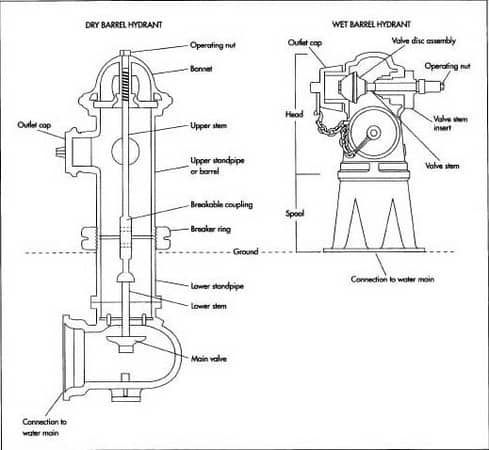
Who decides fire hydrant color?
At first glance, color may seem like a minor detail but the hydrant color system functions in three important ways: first, colors give firefighters and other professionals instant information about the unit's status and water flow; second, a colored hydrant can indicate the water source; and third, painted hydrants indicate the likelihood that regular upkeep and maintenance are being performed.
NFPA 291 is a "recommended practice;" thus, its color chart is not enforceable unless a jurisdiction determines that it is. Many municipalities and fire departments choose to follow NFPA strictly, others use some of the recommendations but make exceptions, and there are some areas that create their own unique color code.
OSHA also publishes standards to address hazards and protect water safety which encompasses water coming from hydrants. OSHA advises using color to distinguish between potable and non-potable water sources—with violet indicating the latter—and also recommends black paint for defunct or temporarily non-working hydrants.
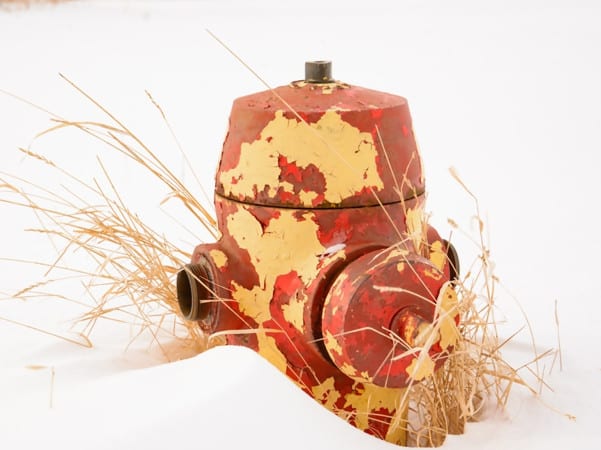
The basic NFPA fire hydrant color palette
Hydrant barrels are red or yellow
Red and yellow barrels have specific meanings. While caps (or bonnets) may be painted a different color to indicate their flow rate (which will be outlined in the next section), many hydrant barrels are painted a single, uniform color. This reflects NFPA 291, which specifies the following:
All public fire hydrants should have yellow barrels and NFPA recommends using a reflective color:
From the 2019 edition of NFPA 291
5.2.1.1 All barrels are to be chrome yellow except in cases where another color has already been adopted.
5.2.1.3 For rapid identification at night, it is recommended that the capacity colors be of a reflective-type paint.
Red barrels are recommended for any private fire hydrant that is on public property. NFPA 291 addresses this using nearly identical verbiage in two sections (and the reflective paint recommendation also applies):
5.2.1.9 [and 5.2.5.2] When private hydrants are located on public streets, they should be painted red or another color to distinguish them from public hydrants.
Other barrel colors commonly adopted due to various local requirements are reflective white and silver. And in some jurisdictions—for example, the state of Texas—the color black has been legislated for non-working hydrants. NFPA 291 does not mention the color black but it does address what to do in case of a permanently nonworking hydrant (remove it) or a temporarily nonworking unit (secure a bag over it):
5.2.2 Permanently Inoperative Hydrants. Fire hydrants that are permanently inoperative or unusable should be removed.
5.2.3 Temporarily Inoperative Hydrants. Fire hydrants that are temporarily inoperative or unusable should be wrapped or otherwise provided with temporary indication of their condition.
Hydrant bonnets and caps
Bonnets and caps are also commonly painted to follow NFPA guidelines for arguably the most important piece of data: water flow. The color of the cap concisely summarizes the water available at a given hydrant and, ultimately, the rate of flow and pressure are the two biggest safety concerns for firefighters.
When estimating the size of the fire they are up against, firefighters want to know they will have enough water. The flow has virtually nothing to do with the hydrant itself, however. Flow rate depends on the size of pipe, including the water main, and whether the main below the hydrant is a primary feeder, secondary feeder, or distributor. Hydrants above larger mains (12" to 16") are more likely to have high flow due to the size of the pipe, although feeder pipe diameters vary widely in size. A high flow rate is generally considered 1,500 GPM (gallons per minute).
NFPA classifies hydrants into four classes:
From the 2019 edition of NFPA 291
5.1 Classification of Hydrants. Hydrants should be classified in accordance with their rated capacities [at 20 psi (1.4 bar) residual pressure or other designated value] as follows:
(1) Class AA — Rated capacity of 1500 gpm (5700 L/min) or greater
(2) Class A — Rated capacity of 1000–1499 gpm (3800–5699 L/min)
(3) Class B — Rated capacity of 500–999 gpm (1900–3799 L/ min)
(4) Class C — Rated capacity of less than 500 gpm (1900 L/ min)
In the case of a smaller, non-structural fire—for example, a burning vehicle or yard debris—the lowest flow rate (under 500 GPM) could be sufficient. (This rate is categorized "inadequate" by NFPA). For a multi-story home or multi-story apartment building, a higher flow rate is needed.
To mark flow rate, NFPA 291 outlines painting the tops and nozzle caps with the following scheme [brackets added]:
5.2.1.2 The tops and nozzle caps should be painted with the following capacity-indicating color scheme to provide simplicity and consistency with colors used in signal work for safety, danger, and intermediate condition:
(1) Class AA — Light blue [1,500 GPM or greater]
(2) Class A — Green [1,000—1,499 GPM]
(3) Class B — Orange [500–999 GPM]
(4) Class C — Red [less than 500 GPM]
Note that this exact color scheme is also recommended by The American Water Works Association.
During routine maintenance of hydrants (even those used infrequently) ascertaining an accurate flow rate is the primary aim because low flow will inevitably impede firefighting. Inspectors utilize pitot gauges to inspect and evaluate pressure in the surrounding pipes in order to assess this flow.
Additionally, water safety issues can arise if pipes in the vicinity of the hydrant lose pressure. A pressure drop below 20 PSI can impact the public water supply since contaminated groundwater may enter a freshly created low-pressure piping system. Pipes that drop pressure can affect the whole system, so regular maintenance by Fire Marshalls and other officials is critical with all hydrants, whether they are frequently used or not.
Additional NFPA fire hydrant markings
Finally, certain customized markings can be found on different hydrants to provide specific information including low PSI, rated capacity, group-flow capacity, and location of flush hydrants:
From the 2019 edition of NFPA 291
5.2.1.4 Hydrants rated at less than 20 psi (1.4 bar) should have the rated pressure stenciled in black on the hydrant top.
5.2.1.5 In addition to the painted top and nozzle caps, it can be advantageous to stencil the rated capacity of high-volume hydrants on the top.
5.2.1.7 Where a group of hydrants can be used at the time of a fire, some special marking designating group-flow capacity may be desirable.
5.2.1.8 Marking on private hydrants within private enclosures is to be done at the owner's discretion.
5.2.4 Flush Hydrants. Location markers for flush hydrants should carry the same background color as stated above for class indication, with such other data stenciled thereon as deemed necessary.
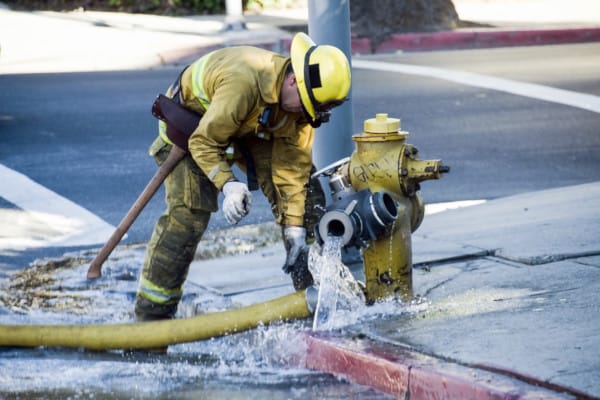
Other select fire hydrant markings
Dead-end water mains and regulated zones
In certain locales, the water pressure must be regulated; there are "neighborhoods in very high pressure areas where the water mains themselves are fed through pressure regulators so that water supplied to domestic users is not so extreme that it could damage water meters and plumbing." In what are known as "Regulated Zones," firefighters are responsible for ensuring hydrant valves are shut off gradually to avoid putting too much pressure on the pipe, regulator devices used, or to the water main itself.
In addition, a hydrant's location within "dead-end mains"—which are "only supplied with water from one end"—may be marked:
In such instances, fire companies pumping "upstream" from other companies can impact water supply to their "downstream" counterparts. By marking the hydrants and direction of water flow, our engine companies can be made aware of the situation and coordinate appropriately among themselves to ensure the available water is adequately shared.
These Regulated Zones may use additional special markings on hydrant caps that are not specified by NFPA, such as:
- An orange-colored "R" inside a circle indicates that the hydrant is in a regulated pressure zone.
- An orange arrow indicates the direction of water flow on a dead-end main.
- An orange arrow and a vertical bar indicate the last hydrant and the direction of water flow on a dead-end main.
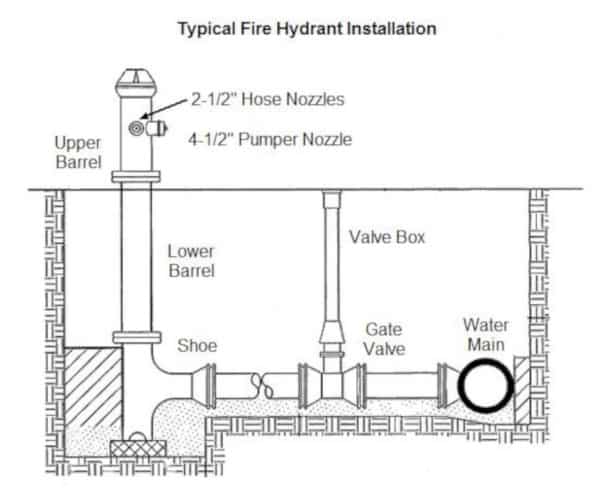
Non-potable or potable water source
OSHA recommends using the color violet to indicate that the water source is non-potable. While this regulation is helpful for water safety, it has little effect on firefighters' top priority: water flow.
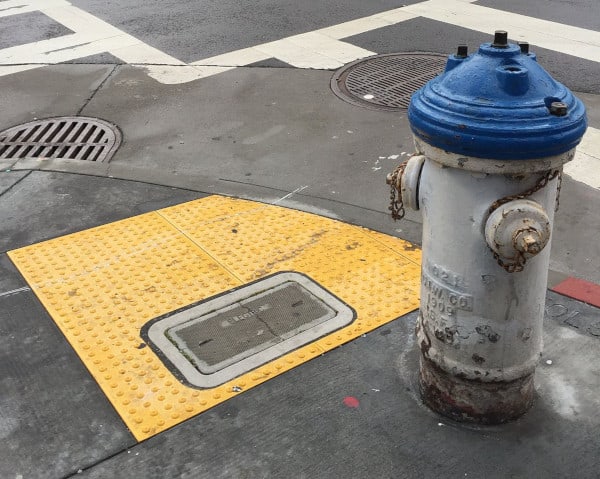
A lack of uniformity and the San Francisco example
The lack of uniformity in color coding can result in minor or major local digressions from NFPA 291. A foolproof color-coding system does not exist nationally, but almost all local fire districts do have a hydrant color code in place. It is unwise to assume that colors strictly follow NFPA 291, and local fire hydrant schema should always be consulted. Professionals in hydrant maintenance are regularly trained in painting standards, including following the local guidelines.
As with all fire safety issues, educating firefighters, government officials, and even citizens on color schemes should be undertaken whenever possible, and keeping updated guidelines, such as these from Spokane, WA, is appropriate public administration practice.
The city of San Francisco offers a confusing lesson on how hydrant colors might vary from national standards. Following the 1906 earthquake, the city developed the Auxiliary Water Supply System (AWSS) which is also known as the HPFS, or High-Pressure Fire System. Various water reservoirs, cisterns, suction connections, pump stations, and even fireboats now form an intricate network of fresh and saltwater resources for emergency back-up.
A total of 1,889 color-coded hydrants can be found in San Francisco. All have colored caps that could be blue, black, or red, depending on their location and water source. In addition, the city has thin and thick hydrants (once dubbed "Laurel and Hardy" hydrants), and the sizes reveal information about their pressure.
San Francisco developed its overall water system as a response to the 1906 disaster, along with the unique color schemes. And just to make things interesting, a lone hydrant, painted in gold, is left to commemorate the earthquake. Near Dolores Park in the Mission District, this hydrant supplied water when all others failed.
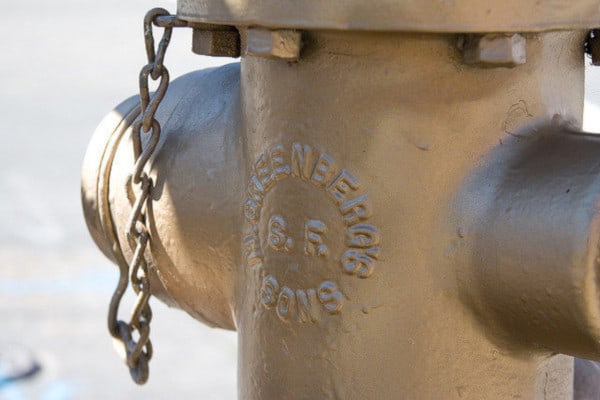
Color coding works despite a diversity of schemes
The painting and labeling of fire hydrant barrels and caps give firefighters and other officials various pieces of data, notably water flow and water source. Colors also contribute to regular maintenance, since older hydrants that show severe fading are prime candidates for testing and repainting to meet code.
NFPA recommendations aren't adhered to in all jurisdictions, but many municipalities have adopted all or part of them. Despite this lack of uniformity across the US, fire hydrant color-coding remains a valuable system for maintaining fire protection readiness and public safety.
If you are looking for fire hydrant caps, Storz fire hydrant caps, Storz adapters for hydrants, or pitot gauges used to test GPM, QRFS has them. You can also check out our blog on converting PSI measurements to GPM during a hydrant flow test, which includes a handy online calculator for quick readings.
If you have any questions or need help finding an item, contact us at +1 (888) 361-6662 or [email protected].
This blog was originally posted at blog.qrfs.com . If this article helped you, check us out at Facebook.com/QuickResponseFireSupply or on Twitter @QuickResponseFS .
schoenbergcruldempan.blogspot.com
Source: https://blog.qrfs.com/286-fire-hydrant-colors-their-nfpa-spectrum-and-meaning/
Post a Comment for "What Is the Blue Circl3 on a Fire Hydrant"